The Knicks‘ 47-35 record in 2022/23 was their best mark since the days of Carmelo Anthony and Mike Woodson, and their first-round triumph over Cleveland last year was the team’s first playoff series win in a decade. So the fact that they were even better in 2023/24 was no small feat.
This year’s Knicks improved their record to 50-32, and while they didn’t advance any further in the playoffs this spring than they did in 2023, they put up a stronger fight in the second round, taking a 3-2 lead over Indiana before a series of injuries caught up to them.
Jalen Brunson, who began heading down a path toward stardom in his first year as a Knick, completed that journey this past season, finishing fifth in MVP voting and claiming a spot on the All-NBA second team. He set new career highs in points (28.7) and assists (6.7) per game while providing crucial availability (77 starts) for a Knicks team that battled the injury bug all season long.
Brunson’s emergence as a legitimate star raises the team’s ceiling on the court going forward and changes the outlook for the front office. It seems safe to assume that head of basketball operations Leon Rose won’t be looking to acquire a ball-dominant guard (like, say, Donovan Mitchell) anytime soon.
Brunson has become the star point guard New York had been missing for so long, reducing any urgency the club might have felt to package assets in a trade for an impact player. Most of those assets are still on hand and could be used on the trade market if the right opportunity arises, but the Knicks can afford to be patient in waiting for that right deal, shifting their focus to wings, forwards, and big men rather than lead guards.
While the Knicks’ injury woes may have prevented the club from making a deeper playoff run, they created opportunities for players who otherwise wouldn’t have played such substantial roles. Isaiah Hartenstein, Donte DiVincenzo, Miles McBride, and Precious Achiuwa were among those who thrived upon taking on additional responsibilities. That should pay off in the long run, assuming New York is able to keep its roster intact (Hartenstein and Achiuwa are free agents, as is midseason acquisition OG Anunoby).
Running it back with a similar group would give the team one of the NBA’s deepest rosters once Julius Randle, Mitchell Robinson, Anunoby, and Bojan Bogdanovic are back to full health. And, having seen the way those reserves performed in increased roles, the Knicks are in position return to the trade market confident they’ll still have plenty of depth even if they give up multiple solid rotation pieces in a deal for a single player, like they did when they gave up Immanuel Quickley and RJ Barrett for Anunoby in December.
Knicks fans have had a rough go of it for the last couple decades, but the team’s future looks brighter now than it has at virtually any other point in the 21st century.
The Knicks’ Offseason Plan
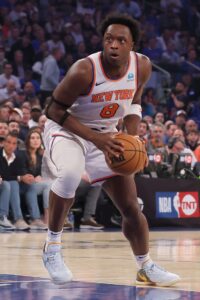 Re-signing Anunoby is an important first step for the Knicks this summer. The former Raptor is one of the NBA’s best three-and-D players – he has a .383 3PT% over the past five seasons and an All-Defensive nod under his belt – and his impact in his first 23 games as a Knick was undeniable. The team’s net rating during his 802 regular season minutes was an incredible +21.7. New York’s offensive rating (122.6) and defensive rating (100.9) during those minutes both would’ve ranked first in the NBA.
Re-signing Anunoby is an important first step for the Knicks this summer. The former Raptor is one of the NBA’s best three-and-D players – he has a .383 3PT% over the past five seasons and an All-Defensive nod under his belt – and his impact in his first 23 games as a Knick was undeniable. The team’s net rating during his 802 regular season minutes was an incredible +21.7. New York’s offensive rating (122.6) and defensive rating (100.9) during those minutes both would’ve ranked first in the NBA.
Anunoby’s injury history is a concern. He has been unavailable for at least 29 games in three of the past four seasons (he missed 15 in the fourth) and was on the shelf for most of the second-round series vs. Indiana last month. Plus, if a cap-room contender like the Sixers or Thunder gets involved in the bidding, his price as a free agent could rise higher than what the Knicks would prefer to pay. But New York didn’t acquire him to be a rental, and he’s been such a perfect fit that it’s hard to see the club letting him get away unless a rival suitor comes in with a long-term, maximum-salary offer.
Another team could offer Anunoby up to a projected $182MM over four years; the Knicks would likely be more comfortable with something in the four-year, $140-150MM range. We’ll have to wait to see if that’ll be enough to get it done or if they’ll face a decision on whether to match (or top) a higher bid.
The decision on Hartenstein should be a bit more straightforward. Since the Knicks hold the big man’s Early Bird rights, they’re limited to offering him a 75% raise on his previous salary. That works out to a starting salary around $16.2MM and a maximum four-year total of approximately $72.5MM. New York will have to determine whether it’s comfortable offering that full amount, which would be a significant investment in a player who is coming off a two-year, $16MM deal and who was averaging just 17.0 minutes per game before Robinson went down with his ankle injury.
It’s possible – but not certain – that another team would be willing to go even higher than $72.5MM over four years for Hartenstein, a reliable defender, strong rebounder, and good passer. An oversized short-term deal that guarantees him a substantial amount of money in the next couple years could also be an option for a team trying to steal him from the Knicks. However, the 26-year-old is said to be seeking long-term security and has spoken highly of his experience in New York, so if the Knicks make him a competitive offer, my guess is he’ll accept it, like Malik Monk did with the Kings’ Early Bird offer.
Re-signing both Anunoby and Hartenstein would be a big win for the Knicks, but it would also be expensive. Let’s pencil in a $35MM starting salary for Anunoby and assume Hartenstein gets his maximum first-year Early Bird salary. That’ll increase the Knicks’ total guaranteed salaries for 2024/25 to about $158MM for nine players, assuming Jericho Sims‘ inexpensive team option is picked up (which should be a lock)
If we assume the team guarantees Bogdanovic’s full $19MM salary (it’s currently partially guaranteed for $2MM), we’re up to nearly $175MM for 10 players. The Knicks don’t have to hang onto Bogdanovic, though recent reporting has suggested they probably will. He wasn’t great after the midseason trade that sent him from Detroit to New York, but Bogdanovic has been a reliable scorer and shooter for years and his expiring contract could serve as a useful salary-matching piece in a trade.
Bringing back those three players would push the Knicks’ team salary above the luxury tax line without accounting for either of their first-round picks. Or restricted free agent Achiuwa. Or unrestricted free agent Alec Burks. Or players to fill out the rest of the 15-man roster. It’s possible the club’s total salary could ultimately surpass the second tax apron in that scenario.
I don’t expect that to happen though, since being a second-apron team would prohibit the Knicks from aggregating player salaries in a trade, which would seriously hinder their ability to be opportunistic if and when a star becomes available. I expect the front office to make a concerted effort to at least remain below the second apron, and perhaps below the first apron too — operating over either apron would prohibit the Knicks from taking back more salary than they send out in a trade.
Avoiding one or both aprons would mean making a sacrifice somewhere else on the roster if both Anunoby and Hartenstein re-sign (if one of them walks, it likely won’t be an issue). Maybe that means waiving Bogdanovic. Maybe it means moving Robinson — a deal with the Thunder could make sense, given their rebounding woes, their available cap room, and their collection of draft assets. Achiuwa might also be a cap casualty unless the Knicks can get him back at a pretty favorable price, and I’d expect New York to trade at least one of its first-round picks (at No. 24 and 25), opening up that roster spot for a minimum-salary player.
While the Knicks should once again put themselves in position to trade a star, it’s unclear if the right fit will be out there this offseason. There has been plenty of speculation over the years about Karl-Anthony Towns, a CAA client who previously played for head coach Tom Thibodeau, and Towns’ ability to space the floor makes him an intriguing target. But he’ll be on one of the NBA’s most expensive long-term contracts beginning in 2024/25 and he’s not the sort of two-way contributor Thibodeau prefers.
I’d consider Paul George and Jimmy Butler two potential trade candidates who would be more logical fits for New York. George is a CAA client and Butler previously played for Thibodeau in both Chicago and Minnesota. More importantly, both players are capable of sharing the offensive load with Brunson and defending at a high level on the other end of the court.
It remains to be seen whether either player will be attainable though. George would probably have to pick up his player option for 2024/25 and push for a trade to New York — if he extends with the Clippers or declines his option to become a free agent, he’ll almost certainly be off the table for the capped-out Knicks. As for Butler, while there has been speculation that his contract demands might result in a standoff between him and the Heat, it’s still hard to imagine a scenario in which Miami agrees to trade him to one of its primary Eastern Conference rivals.
Some combination of Randle, Bogdanovic, and Robinson, along with draft assets, would likely need to be included in a trade for a maximum-salary player like George or Butler. In addition to their two 2024 first-round picks, the Knicks control all their own future first-rounders, as well as protected 2025 picks from Detroit, Washington, and Milwaukee.
Finally, we should touch on a pair of contract extension negotiations worth watching this offseason. Both Thibodeau and Brunson are entering contract years (Brunson holds a 2025/26 player option) and figure to be offered new deals soon, if they haven’t been already.
It sounds like it’s a matter of when, not if, Thibodeau is extended, though it remains to be seen how much he’ll paid and how many years he’ll get. A multiyear deal in the neighborhood of $10-11MM per year seems about right, given the rising salaries for head coaches around the NBA.
As for Brunson, he’ll be eligible to sign a four-year extension worth approximately $157MM. Waiting another year would make him eligible for a deal worth up to a projected $270MM over five years. There has been some speculation that he’ll be willing to do a deal sooner rather than later, which would be a great outcome for the Knicks, but even if it doesn’t get done this offseason, they shouldn’t be worried — yes, he could become a free agent in 2025, but there’s no indication he’d consider leaving New York at that time. Waiting the extra year would just be about maximizing his earnings.
Randle will also be extension-eligible this summer, but I’d be surprised if he gets a new deal done, given that he’ll spend most of the offseason recovering from shoulder surgery and isn’t necessarily a lock to be part of the Knicks’ long-term plans like Brunson is.
Salary Cap Situation
Guaranteed Salary
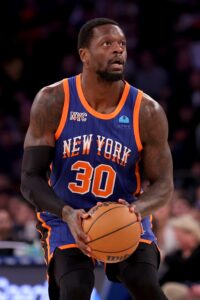 Julius Randle ($28,939,680)
Julius Randle ($28,939,680)
- Randle’s cap hit includes a $27,561,600 base salary and $1,378,080 in likely incentives.
- Jalen Brunson ($24,960,001)
- Josh Hart ($18,144,000)
- Mitchell Robinson ($14,318,182)
- Donte DiVincenzo ($11,445,000)
- Miles McBride ($4,710,144)
- Bojan Bogdanovic ($2,000,000)
- Partial guarantee. Rest of salary noted below.
- Total: $104,517,007
Non-Guaranteed Salary
- Bojan Bogdanovic ($17,032,850)
- Partial guarantee. Rest of salary noted above. Bogdanovic’s salary will become guaranteed if he remains under contract through June 28.
- Mamadi Diakite ($2,273,252)
- Total: $19,306,102
Dead/Retained Salary
- None
Player Options
- OG Anunoby ($19,928,571): Bird rights
- Total: $19,928,571
Team Options
- DaQuan Jeffries ($2,463,946): Early Bird rights
- Jericho Sims ($2,092,344): Bird rights
- Sims’ salary would be partially guaranteed for $651,180 if his option is exercised. That guarantee would increase to $1,302,359 after July 16 and to full after August 16.
- Total: $4,556,290
Restricted Free Agents
- Precious Achiuwa ($6,275,862 qualifying offer / $13,138,581 cap hold): Bird rights
- Total (cap holds): $13,138,581
Two-Way Free Agents
Note: Because he has finished each of the past two seasons on a two-way contract with the Knicks, Washington’s qualifying offer would be worth his minimum salary (projected to be $2,168,944). Brown is no longer eligible to sign a two-way contract and would also have a qualifying offer worth his minimum salary (projected to be $2,244,249). Those offers would each include a small partial guarantee.
Draft Picks
- No. 24 overall pick ($2,833,800 cap hold)
- No. 25 overall pick ($2,720,040 cap hold)
- No. 38 overall pick (no cap hold)
- Total (cap holds): $5,553,840
Extension-Eligible Players
- OG Anunoby (veteran)
- Extension-eligible until June 30 (or beyond, if player option is exercised).
- Jalen Brunson (veteran)
- Alec Burks (veteran)
- Extension-eligible until June 30.
- Julius Randle (veteran)
- Extension-eligible as of August 3.
- Mitchell Robinson (veteran)
- Jericho Sims (veteran)
- Team option must be exercised.
Note: Unless otherwise indicated, these players are eligible for extensions beginning in July.
Unrestricted Free Agents
- Alec Burks ($19,930,240 cap hold): Bird rights
- Isaiah Hartenstein ($12,018,657 cap hold): Early Bird rights
- Shake Milton ($2,093,637 cap hold): Non-Bird rights
- Total (cap holds): $34,042,534
Cap Exceptions Available
Note: The Knicks project to operate over the cap and under the first tax apron. If they approach or exceed the first apron, they would lose access to the full mid-level exception, the bi-annual exception, and their trade exceptions and would gain access to the taxpayer mid-level exception ($5,183,000). If they exceed the second apron, they would lose access to all of their exceptions.
- Non-taxpayer mid-level exception: $12,859,000
- Bi-annual exception: $4,681,000
- Trade exception: $6,803,012
- Expires on July 8.
- Trade exception: $5,241,072
- Trade exception: $3,873,025
Note: Unless otherwise indicated, trade exceptions don’t expire before the regular season begins.
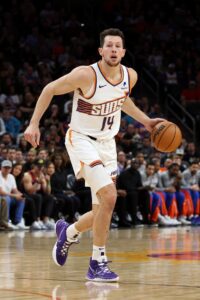 Eubanks, 27, signed a one-plus-one (second-year player option) deal with Phoenix last summer, appearing in 75 games and averaging 5.1 PPG, 4.3 RPG and 0.8 BPG as the team’s primary backup center (15.6 MPG).
Eubanks, 27, signed a one-plus-one (second-year player option) deal with Phoenix last summer, appearing in 75 games and averaging 5.1 PPG, 4.3 RPG and 0.8 BPG as the team’s primary backup center (15.6 MPG).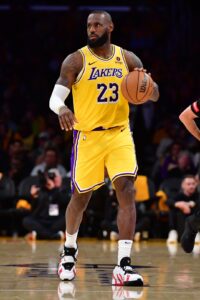 Woike’s report isn’t surprising. Rich Paul of Klutch Sports, James’ agent,
Woike’s report isn’t surprising. Rich Paul of Klutch Sports, James’ agent, 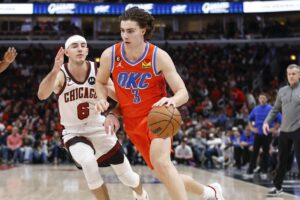 While Chicago’s statement doesn’t have any quotes from the front office, Thunder head of basketball operations Sam Presti was remarkably transparent, at least from his perspective, about how and why the trade transpired.
While Chicago’s statement doesn’t have any quotes from the front office, Thunder head of basketball operations Sam Presti was remarkably transparent, at least from his perspective, about how and why the trade transpired.